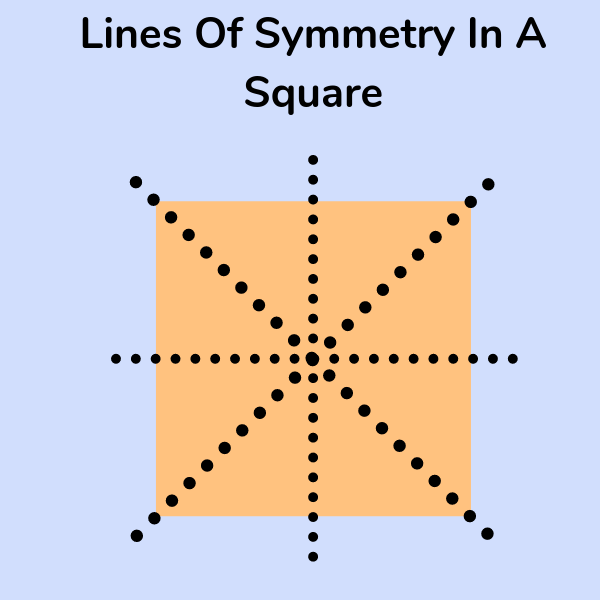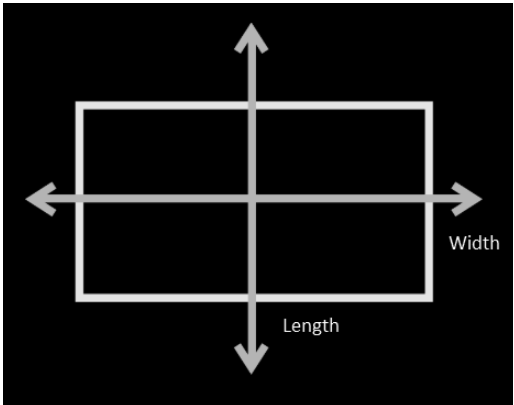
The image shows rotational symmetry about the center axis that comes out of the paper. However, the result after rotation must have the same image as before rotation. If the object’s shape remains the same when rotated about an axis, then that object is said to have rotational symmetry. As you can see in the figure, the image has translation symmetry as it slides from one position to another. In simpler terms, if an object can slide symmetrically, then it is translation symmetry. If the object has symmetry along its forward and backward paths, it is said to have translation symmetry.
#Lines of symmetry in a rectangle how to
Now, coming to how to determine which line of symmetry is which, let’s look below! Types of Line of Symmetry If the thickness is not similar, the objects will not have any line of symmetry. Hence, every 3D body will have at least one line of symmetry if its thickness is the same along its length. However, if you view these shapes in 3D, like a real key, and see them from the top, they will have one line of symmetry and their thickness. If you see these figures in 2D, they will look asymmetrical. The point to be noted here is that though these objects do not have any lines of symmetry, as can be seen in the figure, they will somehow be similar. The given shapes below do not have any axis of symmetry. This is due to the fact that they do not have any symmetrical axes. These objects are known to have zero lines of symmetry. Various objects do not have any lines of symmetry. Since the shape is symmetrical along all its infinite axes hence, it has infinite lines of symmetry. These lines of symmetry pass through the center of the shape and the mid-way of its sides towards the corners, as shown in the figure.Ī circle has infinite lines of symmetry. Unlike other triangles, such as scalene, isosceles, or right-angled, an equilateral triangle is the one that has maximum lines of symmetry. If you wonder how many lines of symmetry a rectangle has, you should know it has two lines of symmetry, i.e., one horizontally and another vertically.Īn equilateral triangle has three lines of symmetry. The shape can be cut only vertically, producing mirror images. A few of the shapes’ lines of symmetry are discussed below.Ī kite has only one line of symmetry. However, various shapes have infinite lines of symmetry. Each shape can either have one, two, three, or any specific number lines of symmetry. Various shapes and figures have different lines of symmetry. Understanding how many lines of symmetry a body has? Now let’s come to how many lines of symmetry are there in a particular object. ‘What is a line of symmetry’ has been discussed. An object can have more than one line of symmetry depending on the object’s geometry. Hence, it is also called reflection symmetry. This line of symmetry is also known as the mirror line because it presents two reflections of an image with the same dimensions that can coincide. Hence, with every fold along the line of symmetry, you will get a similar shape or object. And if you further fold the square along the diagonal lines of symmetry, you will get more triangles. If you further fold the square along the vertical line of symmetry, you will get four small squares. You will get two similar small rectangles if you fold the square horizontally along the straight line. If you see the figure, a square is made initially. Let us take another example and understand the line of symmetry.

Hence, the term symmetry means the state of having two halves that match each other exactly in size, shape, and other parameters.Īs seen in the above starfish and octopus example, you will get similar shapes if you cut them along their axis of symmetry.

The term symmetry comes from a Greek word ‘sun + metron’, which later transformed into Latin ‘symmetria’, meaning ‘with measure’.

This axis is known as the axis of symmetry. If you fold the body along this axis, you will get two or more similar figures. Line of Symmetry DefinitionĪ line of symmetry is an imaginary line or axis which passes through the center of a body or an object. Doesn’t it look symmetrical from either side if you draw an imaginary axis along your face? Now, let us understand what a symmetrical body or simply, symmetry means. Or, if an octopus is cut along its head, it will also produce similar shapes. For example, if a starfish is cut across its limbs, you will get similar shapes. A symmetrical body is an object or thing that can be cut along a particular axis, producing similar shapes. Have you wondered why your mirror reflection appears symmetrical while a few objects do not? Or could you guess what the similarity between two marine animals – a starfish and an octopus are? If you guessed they have a symmetrical body, then you are correct.


 0 kommentar(er)
0 kommentar(er)
